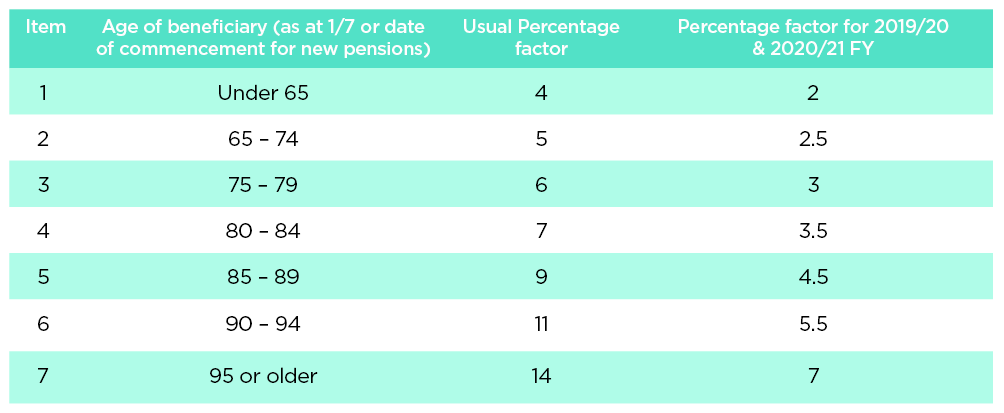By Anthony Cullen

Superannuation benefit payments in a COVID 19 environment
As a result of the economic impact of COVID 19 the Federal Government has announced a series of initiatives to help cushion the blow of these extraordinary times. On 24 March 2020 the Government’s Coronavirus Economic Response Package Omnibus Act 2020 received royal assent. As it did in the wake of the Global Financial Crisis, the Government has reduced the minimum drawdown requirements on some pensions, which will be the main focus of this article.
In relation to Account Based Pensions (ABP), minimum income stream benefits are determined by multiplying the balance of your ABP interest by the relevant pension factor, per the below table.

Superannuation regulations state that the amount determined is to be rounded to the nearest 10 whole dollar (with amounts ended in exactly $5 being rounded up). Although it may be tempting to do so, simply halving the minimum amount that may have previously been calculated may result in an incorrect amount being withdrawn. The correct application of the law is to halve the percentage requirement used in the calculations rather than the dollar amount determined as the minimum requirement.
Take George for example. On 1 July 2019 he was 75 years of age, with an ABP balance of $585,233. Based on the table above, his default drawdown would be 6%, being $35,110 (rounded). If he were to half this amount, he may believe he now only has to draw $17,555. However, if he were to apply the lower percentage requirement prior to any rounding he would correctly re-calculate his minimum to be $17,560.
Although most would look at this variance as immaterial it still has the potential to create a situation where the pension standards have been breached as a result of not paying the minimum pension requirement. This issue could be easily avoided if the rounding is applied at the right time.
These halving of minimum requirement measures also apply to the following pensions:
Where these pensions have a maximum withdrawal limit, there is no change to calculating said maximum.
Withdrawals from complying pensions that are determined by an actuary cannot be halved under these temporary provisions. Pension payment requirements will continue to be in accordance with the original expectations.
Adjusting prior payments
Where you have been receiving regular pension payments during the course of this income year, with the minimum drawdown rates now reduced, it’s entirely possible you have already received more than the required minimum pension payment amount for this income year. We have received numerous questions about whether it’s possible to re-classify pension payment amounts that have already been paid, and which exceed the reduced minimum drawdown amount, as lump sum withdrawals rather than pension payments. This is due to the fact there may be benefits from having withdrawals treated as lump sums.
Having payments treated as lumps sums will impact on your Transfer Balance Account (TBA) and may free up space within your Transfer Balance Cap (TBC), potentially allowing for further strategies in the future. Further to this, if you are under the age of 60, accessing the lump sum low rate cap may provide greater tax benefits at an individual level than receiving pension payments.
There are several concerns to be contemplated before implementing such a strategy. As regulators of SMSFs, the ATOs view on changing the treatment of payments is an important starting point. The below Q&A has been taken directly from the ATOs Frequently Asked Questions page dealing with COVID 19 and superannuation:
Question: I am retired and receive an account-based pension from my SMSF. My account-based pension has already paid me more than the reduced minimum annual payment required for the 2019–20 financial year. Is the amount over the minimum considered superannuation lump sum amounts?
Answer: Pension payments that you have already received cannot be re-categorised. Accordingly, payments made from your account-based pension in excess of the new reduced minimum annual payment required for the 2019–20 financial year are pension payments (that is, superannuation income stream benefits) for the year and not superannuation lump sums.
Further to this, the following needs to be considered before attempting to make any adjustments to prior payments:
Any benefit payments that were previously classified as pension payments prior to 25 March 2020 were made based on the law at that point in time, that is, in accordance with the default percentage factors. In the event of an audit, it may be difficult to justify a claim of meeting the reduced minimum requirements before the law had been changed.
Let’s return to George. In order to meet his original minimum ($35,110) George was receiving a monthly drawdown of $2,926 on the first day of each month. From 1 July 2019, to the date of Royal Assent (24 March 2020), George has received payments totaling $26,334. As this amount exceeds George’s reduced minimum drawdown amount of $17,560, he is not required to withdraw any further amounts for the remainder of 2019/20.
Assuming George continues to receive the monthly payments, he may look at the potential benefits of treating the remaining payments for the year as lump sum benefits. What George is unable to do is have any of the previous monthly pension payments re-classified. They must remain as pension payments.
Where you also have an accumulation account in the fund, and you have unrestricted access to that account, it will be tempting to reclassify pension payments in excess of the new reduced drawdown amount as lump sum withdrawals from the accumulation account. This will have the effect of increasing the fund’s exempt current pension income deduction. Once again, this reclassification cannot occur if the documentation on file supports the fact that the payment was a pension payment.
One final point on pension payments; they must be paid in cash. As of 1 July 2017, lump sum payments are no longer able to be used to meet minimum pension requirements. As the end of the 2019/20 financial year approaches, and even though the minimum drawdown rates have been reduced, if the new reduced minimum pension amount has not yet been paid, and the cash holdings and/or cashflow of your fund have decreased (because for example the fund’s investment income has reduced as a result of the COVID-19) it may be prudent to start considering how payments will be funded prior to the end of the year now.
Temporary Early Access to Super (TEAS)
A second superannuation measure that may assist you cope with the impact of COVID 19 is a newly created temporary condition of release that may allow early access to your benefits. For further details about the eligibility criteria please refer to our previous article on accessing your super here. That article explores, not only TEAS but other conditions of release that may provide additional options to accessing superannuation.
As part of the application process, you are required to certify that you satisfy the eligibility criteria. You can apply for TEAS via your myGov account. If you don’t have a myGov account or cannot access it, applications can be completed over the phone by contacting the ATO. Although you may not need to supply any supporting evidence of eligibility as part of the application, you will be required to maintain it on file in case you are asked to produce it at a later date.
After you have verified your identity, you will see a list of funds, along with the available balance in each account, that they can select to access benefits from. In the case of a new SMSF, which has yet to lodge its first annual return with the ATO, no balance will appear but that doesn’t preclude you requesting an amount to be withdrawn from your SMSF. In this situation, the determination issued by the ATO will stipulate the amount that can be withdrawal from the SMSF and it will be up to you, as the trustee of the SMSF, to determine if there are sufficient funds in your member account. You can choose up to five accounts but are limited to only one application in this financial year, and another application next financial year, as long as that application is made before 24 September 2020. Regardless of how many accounts are chosen, the maximum amount that can be accessed is $10,000 per application. Recent changes mean certain temporary residents may also be eligible to access their super under TEAS, although they will only have the one opportunity to access their super in the 2019/20 financial year.
The ATO expect to issue notices of acceptance or rejection within four days but depending on volumes of applications may do so within one to two days. The main difference between SMSF and APRA fund members is that release authorities for APRA funds will be sent directly to the fund, whereas if you are an SMSF member you will receive any notifications directly from the ATO. You will then be required to supply the release authority to the trustees, in most circumstances this will be yourself.
Once a trustee receives a valid determination it is expected that payments are made as soon as practicable, as a single lump sum amount not exceeding the amount stated on the determination. A lower amount may be paid if your account balance is insufficient to cover the stated amount or you formally document a request to the trustee for a lower amount. However, you will be unable to request a top up of the remaining amount at a later date.
It is important to note that the application process must be followed and a favourable determination must be issued by the ATO before you are able to access your SMSF benefits. Accessing benefits without meeting a condition of release may result in action being taken for illegal early access of benefits.
We are aware of strategies which involve members accessing their superannuation savings early under the TEAS and then recontributing the withdrawn amount back to their fund as either a salary sacrifice contribution or as a personal deductible contribution. The ATO has asked individuals, tax agents and businesses to be mindful that it is not acceptable to apply for relief payments where eligibility may be questionable. Applications for relief through stimulus measures which are based on artificial arrangements will see the ATO take swift action.
To stay on top of the latest news in relation to COVID 19 and SMSFs keep an eye on our articles on the SuperConcepts website here. Should you have any queries in relation to this, or any other matters, please feel free to contact your client manager to discuss further.